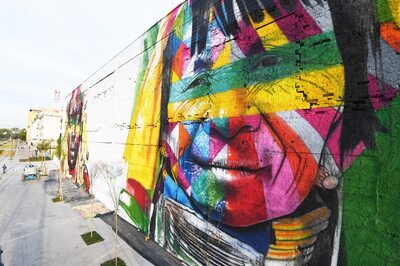
views
New Delhi: Students of JNU clashed with police on Monday after they were stopped from marching to Parliament against a hostel fee hike, paralysing traffic and bringing the city to a halt.
The students also clashed with the police outside Safdurjung tomb near Jor Bagh. While the students alleged that they were batoncharged by police, top police officials denied having used any force.
According to the police, around 30 police personnel and 15 students were injured during the protest in which thousands of students participated from different universities across the national capital.
They had joined the protest march called by Jawaharlal Nehru University (JNU) students against the recent fee hike against which an agitation has been going on for over three weeks.
There was heavy deployment of police and paramilitary personnel outside the main gate of JNU campus, even before the march commenced. Water canons and PCR vans were stationed outside.
Before the protest began, the HRD Ministry set up a three-member committee to recommend ways to restore normal functioning of the university and initiate dialogue with the students and administration.
The protesters commenced the march around noon and broke the first set of barricades at the main gate of the campus and proceeded towards Baba Gangnath Marg where another set of barricades awaited them.
The police detained about 100 protestors, including JNU Students Union president Aishe Ghosh, Secretary Satish Chandra Yadav and former JNUSU president N Sai Balaji. The students then took at an alternative route through the Munirka village and came near the Munirka metro station.
They raised anti-government and anti-administration slogans and started marching towards RK Puram from where they reached Bhikaji Cama place and subsequently marched onto Ring Road causing traffic to come to a halt at many intersections.
The students were ultimately stopped outside Safdarjung Tomb where, they alleged, the police baton- charged them, a charge denied by the police.
Meanwhile, the top brass of Delhi police tried to initiate a dialogue with them and urged them to not take law into their hands. Traffic was also affected in some parts of Lutyens' Delhi as the students marched towards Parliament. Among other intersections, vehicles were moving at a snail's pace on Nelson Mandela Marg, Aurobindo Marg and Baba Gang Nath Marg.
The entry and exit points of three Delhi Metro stations near Parliament — Udyog Bhawan, Central Secretariat, Patel Chowk and Lok Kalyan Marg, were shut down temporarily and trains did not halt at Udyog Bhawan and Patel Chowk. The services resumed four hours later.
Students took to Twitter to share pictures of the march and of the injuries they received allegedly in the lathicharge, as the hashtag "emergencyinJNU" trended on the microblogging site.
The students camped outside the Safdarjung tomb for nearly four hours. The detained students were released later in the evening and police escorted a delegation of four JNUSU members to HRD secretary.
JNUSU members claimed that they met HRD Joint Secretary GC Hosur and handed over a memorandum of demands, including rollback of the fee hike and sacking the vice chancellor. However, there was no official word from the university about the meeting.
The remaining students were asked by police to leave the venue after the JNUSU delegation left for the meeting. The opposition also slammed the government over the issue.
While the Congress claimed the present dispensation was "afraid" of any varsity which encouraged free flow of thought, CPI(M) general secretary Sitaram Yechury also condemned the alleged police action against students, saying it was not the right way to deal with democratic protests.
In a statement released by the Delhi Police, the department said they did not use force against the protesting JNU students. "There was no use of water cannons, tear gas shells or lathicharge at any stage of the protest. Women staff was deployed in adequate numbers to deal with female protestors. Apart from 10 companies of CAPF, around 800 Delhi Police personnel were deployed to handle the protest and ensure maintenance of law and order," it said.
The JNU Teachers' Association (JNUTA) has also expressed concern over the current situation in the university campus.
(With PTI inputs)


















Comments
0 comment